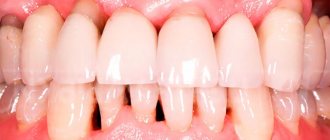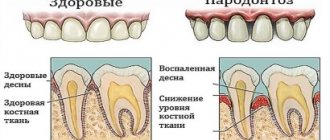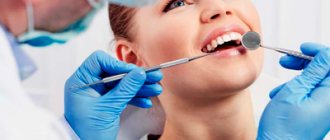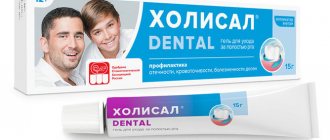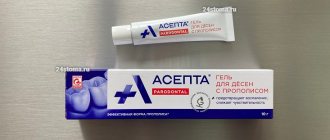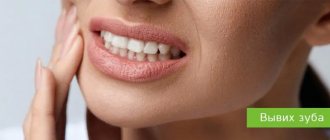Introduction
The information world is very huge. Each of us is haunted by a million points of view
for any problem in any field of knowledge, you just need to ask a search query. The same thing happens in medical circles on the Internet - discussions of health problems are widely represented by both patients and doctors and often reach the point of absurdity:
For example, in questions:
- loosening of the tooth,
- exposure of the neck of the tooth,
- why are my gums and teeth exposed?
that is, in situations where the gums on a tooth have receded, patients are always confused: they have periodontal disease
, then suddenly it changed to
periodontitis
, then periodontal disease returned again. And the search for an answer to the question becomes endless.
The problem of “how to treat periodontal disease” is picked up by doctors who only add fuel to the fire by recommending medications and even folk remedies for periodontal disease, without having sufficient competence to do so.
Let's consider these points of view professionally, and try to convey one simple truth, which for the vast majority of patients (and even some doctors) will be a revelation: the diagnosis of periodontal disease of the gums
» —
does not exist
.
An expert point of view is expressed by the famous periodontist, Doctor of Medical Sciences Laura Mikhailovna Tebloeva:
As a rule, for patients who come to me and say: “I have periodontal disease,” I always clarify - did you make this diagnosis yourself or did you see a doctor? Often patients answer that they have this information from their doctor. It turns out that the patient did not read somewhere and determine the diagnosis of “periodontal disease” for himself, but, unfortunately, such a diagnosis was made by a doctor.
Advantages of prosthetics on implants
- Bone tissue does not decrease, the facial contour is preserved, the smile looks younger;
- the supporting teeth do not deteriorate;
- any number of teeth are restored;
- immediately after implantation, a temporary prosthesis or a permanent ceramic-composite structure is put on (using the Resmile method);
- there is no problem with suction (as in removable ones), the structures are fixed with screws or dental cement.
Work of ROOTT dentists on implant prosthetics for periodontal disease
Always treat gum problems
When a patient comes to the doctor, he complains about something. What symptoms does he see a doctor with before receiving a diagnosis of periodontal disease? What worries him?
Literally, patients tell the doctor this: my gums have sagged, my gums have become exposed, my lower gums have receded. And for some reason the symptom of gum subsidence automatically means that the patient has the so-called. periodontal disease.
More experienced patients, who have already heard a lot of professional terms, who delve into the professional colloquial language of doctors, say this: “The necks of the teeth have become exposed a little, the teeth have become a little higher.” But, according to statistics, most patients complain about sagging gums.
And so, when patients come to the doctor with complaints about the problem of exposed tooth necks, the doctor diagnoses them with periodontal disease. Of course, he begins to treat them. And to treat it specifically for periodontal disease.
But time passes, money also goes away, and the question of why the gums recede and the necks of the teeth become exposed, why the gums recede, has not been resolved. And the patient still has periodontal disease.
Symptoms that require immediate medical attention
Patients often think that if their gums hurt under dentures, then this is normal, so they delay going to the doctor. Swelling and redness appear on the gums. If nothing is done at this stage, erosions and ulcers appear on the mucous membrane. Traumatic (prosthetic) stomatitis develops; drug treatment is needed.
Constant mechanical irritation leads to the formation of papillomas, which can degenerate into tumors.
Burning, discomfort, and unpleasant sensations are sometimes caused by common diseases: diabetes, alcoholism, immunodeficiency states. If you have teeth, in such cases it is better to install clasp dentures, and if this is not possible, then plate products with a soft layer under the base. The soft layer is also used if the palate is rubbed with a prosthesis.
What tactics are used to treat periodontal disease?
I want to start with the fact that patients who come with a diagnosis of periodontal disease, they need, every single one, treatment... not from the periodontist to whom they initially turned.
If we talk about the tactics of managing patients with the so-called. periodontal disease, which then come to me again, it’s a shame to voice this, but the treatment of periodontal disease was carried out right up to injections of Lincomycin into the exposed gum.
According to statistics, almost always the treatment of periodontal disease in adults with medications is burdened with a course of some antibiotics and physical therapy.
And most importantly, the task of all these manipulations is completely unclear: what do doctors want to achieve in this way, to destroy some kind of flora or to stop some destructive processes in the gums? It is very difficult for me to say what happens to the competence of a doctor who injects antibiotics for the so-called. periodontal disease, but this is absolute blasphemy. Is it possible to cure periodontal disease by destroying the flora? As a result, the gums will never recover.
Treatment of gum periodontal disease reaches the point of absurdity
I would like to note the widest range of drugs and folk remedies that patients use to attempt self-treatment of periodontal disease at home. Among the folk remedies, one can note the treatment of periodontal disease with hydrogen peroxide, and even treatment with soda:
What about the use of various toothpastes for periodontal disease? What goals do patients have? The purpose of toothpaste is preventative, not curative. And no toothpaste will eliminate inflammation, because there is no such inflammation in periodontal disease.
It is not difficult to guess that in these combinations of procedures the question of how to cure periodontal disease remains open.
Drug treatment of periodontal disease
The most common medications for the treatment of gums are preparations containing antibiotics and propolis. Antibiotics (Metronidazole, Linkamycin, Trichopolum) in this situation kill pathogenic microflora, preventing further spread of the inflammatory process, and propolis strengthens the gums, has an antibacterial effect and reduces pain in the oral cavity. Regular intake of vitamin and mineral complexes increases not only local, but also the general immunity of the body, thereby achieving quick results in the treatment of periodontal disease. The most accessible products include: Cholisal, Elugel gels, heparin ointment, Troxevasina ointment, Solcoseryl paste for mucous membranes.
There is no inflammation with periodontal disease
When does the so-called periodontal disease, there is no inflammatory process in the gums. The clinical picture of “periodontal disease” differs sharply from periodontitis; it is with periodontitis of the tooth that inflammation occurs.
And injections into the gums, endless restorations of the necks of the gums - this is running in circles. Over time, again all the restoration fillings are chipped, and again these patients come to have these fillings restored again. And this happens endlessly
:
And the diagnosis of “periodontal disease” does not go away. As Desna ran away, she continues to leave. The fillings increase, that is, the teeth increase in size, because the gums sag more and more, and nothing useful happens.
When such a patient gets an appointment with me, unwinding his entire tangle of ordeals during the consultation, it becomes clear that all previously performed gum treatment consists of 3
factors:
- Lost time,
- lost money
- shattered hopes.
The diagnosis was incorrect and the treatment was appropriate for the incorrect diagnosis. What went wrong?
Patients should always go for a consultation with such a diagnosis... to an orthodontist
.
Because periodontal disease is an occlusal injury
.
What I see in these patients with signs of periodontal disease is a completely different diagnosis. This is an occlusal injury that can only be corrected by an orthodontist.
Gum treatment methods
Manipulations depend on the reason:
- in case of allergic reactions, the base is changed to hypoallergenic (nylon, AcryFree), antihistamines are prescribed;
- for papillomas, excision surgery is performed;
- when a removable denture rubs, a correction (relining) is made;
- if the crown falls off, it is soldered back.
To soothe gum inflammation, ointments, infusions and lotions are used.
Pharmacy products:
Kamistad, Metrogyl Denta, Solcoseryl, Cholestal, Asepta. These gels and pastes have analgesic and anti-inflammatory effects. Before applying them to your gums, read the instructions carefully.
Disinfectant solutions:
chlorhexidine, furatsilin, destroy pathogenic flora.
Home remedies:
applications of sea buckthorn and rosehip oil. Rinse in the form of infusions of sage and plantain. Solutions of soda and salt also soothe irritation in the mouth.
What is occlusal injury
Occlusal trauma is when a tooth experiences excessive stress due to:
- the tooth is not in the dentition,
- the tooth is not in the correct position,
- the tooth has not grown physiologically,
- the tooth is tilted, at the wrong angle.
The occlusion of the teeth is impaired. That is, when chewing in a patient with impaired occlusion, a destructive force of chewing pressure is created, and the bone tissue in the area of these above teeth begins to decrease.
What is chewing from a physiological point of view?
It's teeth hitting teeth. The strongest blow, since the masticatory muscles are the strongest in the body.
In simple words, in a patient, from such a hyper-impact, hyper-contraction of the masticatory muscles, which develops during chewing, from this beating of teeth against each other, the bone begins to contract. Bone tissue shrinks. And after the bone, the gum also contracts, because the bone and gum are tightly connected. The gum descends, following the bone. And here we answered the main question - why gums recede.
Let's now begin to form an understanding of the answer to the next question: what to do if your gums have receded.
Reasons why removable dentures rub
Even a well-made removable denture takes some getting used to. A foreign object in the mouth causes psychological problems and can also scratch and irritate the gums. Therefore, correction requires several visits, and adaptation – several weeks. But sometimes correction doesn't help.
Removable dentures rub when:
- The manufacturing technology was violated
: the technician did not polish well enough or did not notice the growth, which irritates the mucous membrane and causes discomfort. - The design is poorly fitted
. - The patient has untreated gum disease
: periodontitis can cause the gums under the dentures to become inflamed; it not only provokes inflammation, but also changes the contour of the gums when they swell.
- Gum recession:
due to bone tissue atrophy, trauma, unsuccessful treatment, the gums “sag” and the structure is no longer suitable.
- Service life:
over time, the base becomes covered with microcracks and roughness, which have an irritating effect.
Orthodontics comes to the fore
Today, a huge mistake is happening both in the search for the causes of periodontal disease and in making a diagnosis, as well as in the method of effective treatment. Instead of putting the tooth into occlusion, removing it from a traumatic bite, patients are offered all these manipulations that I have previously voiced, which are not at all aimed at getting rid of these complaints, but only at the fact that patients are wasting time, the processes are getting worse.
In the treatment of the so-called periodontal disease is a big problem in the loss of time for inadequate treatment, and the loss of time for the patient is a complication of the pathology of dental occlusion, and the transition of the stage of the disease to a more advanced form.
If a patient, for example, three years ago had a loss of bone tissue of two millimeters, then due to the “treatment of periodontal disease” he has already lost five millimeters, that is, we have lost time.
And if he came to the orthodontist with a loss of bone tissue of two millimeters, then it would be easier to stop the loss of gums, it would be easier to eliminate the development of gum pathology after orthodontic treatment, when the teeth become aligned with the dentition.
We can already talk about the fact that we close all exposed necks of gum recession, thereby treating the neck of the tooth. But when patients waste time on treatments that are inadequate for the disease, sometimes closing the recession is no longer possible. Because there are also strict indications and contraindications for the treatment of gum recession.
Which gel is better to choose
To determine which teething gels help best, first of all, you need to familiarize yourself with their composition. Thus, the effectiveness of drugs containing lidocaine and other anesthetics directly depends on the amount of these components in them - the higher it is, the faster the pain relief effect occurs. And although pain relief occurs almost instantly, its return occurs just as quickly - usually 20 minutes after applying the gel. Anesthetic-based products include: Dentol, Kamistad, Kalgel and Dentinox.
«
Another type of no less effective gels for teething are preparations based on completely natural or semi-synthetic components. For example, these include: Cholisal, Baby Doctor and Pansoral. Compared to anesthetic-based gels, these products may have a less pronounced but longer-lasting analgesic effect, which is the result of not just blocking pain with plant substances, but eliminating the cause of its development - inflammation of the gum mucosa.
In general, all of the listed dental gels for newborns or teething children, in addition to their own advantages, have a common drawback - the risk of developing allergies. Therefore, when choosing a gel for teething, you should focus both on the allergic status of the baby and on the previously announced features of the action of each of the groups of drugs.
Thus, gels with an anesthetic will be more effective in a situation where a child has severe pain, which cannot be relieved by natural ingredients. And gels for infants based on plant substances are best suited for moderate deterioration in health, when natural pain relief by reducing inflammation will be sufficient.
«

